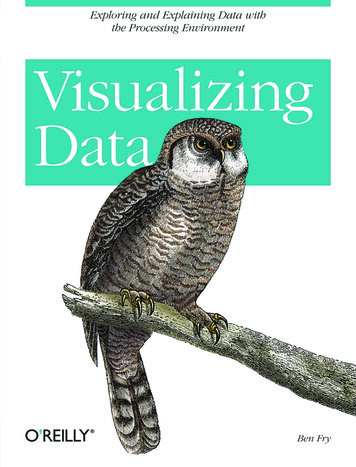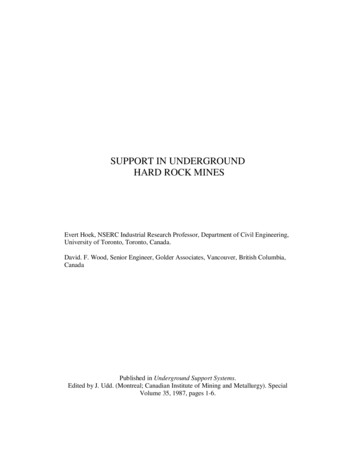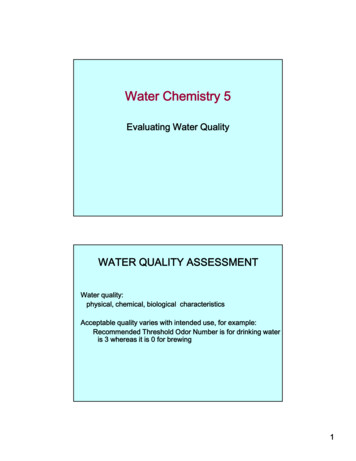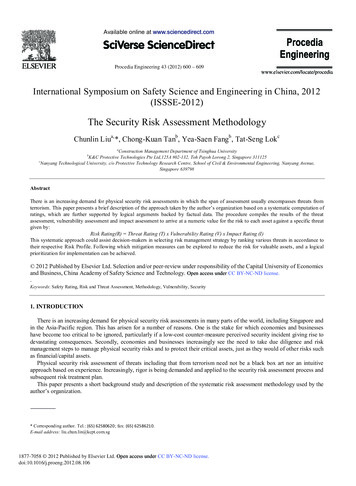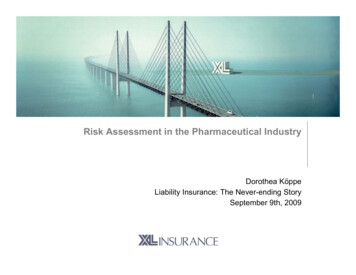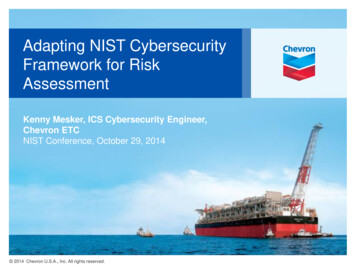
Transcription
Risk assessmentworkbook for minesMetalliferous, extractive and opalmines, and quarriesIGA-019December 2009Mine Safety OperationsDocument controller: Mathew BarnesVersion 5.0IGA-019 (TRIM: OUT09/16488)Page 1 of 64December 2009
DisclaimerThe compilation of information contained in this document relies upon material and dataderived from a number of third party sources and is intended as a guide only in devising riskand safety management systems for the working of mines and is not designed to replace orbe used instead of an appropriately designed safety management plan for each individualmine. Users should rely on their own advice, skills and experience in applying risk and safetymanagement systems in individual workplaces.Use of this document does not relieve the user (or a person on whose behalf it is used) ofany obligation or duty that might arise under any legislation (including the OccupationalHealth and Safety Act 2000, any other Act containing requirements relating to mine safetyand any regulations and rules under those Acts) covering the activities to which thisdocument has been or is to be applied.The information in this document is provided voluntarily and for information purposes only.The New South Wales Government does not guarantee that the information is complete,current or correct and accepts no responsibility for unsuitable or inaccurate material that maybe encountered.Unless otherwise stated, the authorised version of all reports, guides, data and otherinformation should be sourced from official printed versions of the agency directly. NeitherIndustry & Investment NSW, the New South Wales Government, nor any employee or agentof the Department, nor any author of or contributor to this document produced by theDepartment shall be responsible or liable for any loss, damage, personal injury or deathhowsoever caused.Users should always verify historical material by making and relying upon their own separateenquiries prior to making any important decisions or taking any action on the basis of thisinformation.Mine Safety OperationsDocument controller: Mathew BarnesVersion 5.0IGA-019 (TRIM: OUT09/16488)Page 2 of 64December 2009
OBJECTIVEThis workbook is designed to give the user a starting point to identify and manage hazardsat the mine site. It is a step-by-step approach to identify hazards, assess risks andimplement controls.It is consistent with other NSW Mine Safety Operations publications such as the RiskManagement Pocket Guide and the General Workplace Inspection Checklist.The Risk Management Pocket Guide provides a daily prompt for people on the job todevelop their understanding and experience by encouraging the daily discipline of managingrisks whilst carrying out tasks in the mining and quarrying industries.This workbook is designed to take those principles from the Risk Management Pocket Guideand implement them at the mine site from the front gate to the back gate, prompting the userto look at a wide range of hazards.This workbook uses a simplified form of a Workplace Risk Assessment and Control (WRAC).It does not cover all hazards and the user should add those hazards not identified in theworkbook.This workbook highlights the prescribed hazards from the Mine Heath and Safety Regulation2007 and the Occupational Health and Safety Regulation 2001.This workbook allows the user to assess the risks from the identified hazards from low tohigh. This should enable the user to have a better understanding of what hazards have ahigh risk and thus examine if existing controls used are appropriate or need to be reviewed.The General Workplace Inspection Checklist can then be used to ensure that the controlsput in place are effective, utilised and maintained.This workbook should be reviewed on a regular basis to ensure that all identified hazardsare being effectively and efficiently controlled.WHY DO RISK ASSESSMENTS?Risk assessments will help mine operators to identify high, medium and low risk levels. Thisis a requirement of the Occupational Health and Safety Act 2000 (refer Sections 7 & 8). Riskassessments will help to prioritise the risks and provide information on the need to safelycontrol the risks. In this way, mine owners and operators will be able to implement safetyimprovements.WHAT IS RISK ASSESSMENT?A risk assessment involves a detailed and systematic examination of any activity, location oroperational system to identify hazards. The assessment will consider the relationshipbetween the likelihood and potential consequence of the risk of hazards occurring, and toreview the current or planned approaches to controlling the hazards. New or improvedhazard controls are added where required.DEFINITIONS1.HazardA hazard is a source of potential harm or a situation with potential to cause harm (AS/NZS4360 Risk Management).Identifying hazards and compiling information about them is the first step in planning forsafety.Mine Safety OperationsDocument controller: Mathew BarnesVersion 5.0IGA-019 (TRIM: OUT09/16488)Page 3 of 64December 2009
2.Prescribed HazardThe Mine Health & Safety Regulation 2007 requires mines to conduct OH&S riskassessments in relation to certain high risk, prescribed hazards associated with groundinstability, inrush, atmospheric contamination, mine shafts, conveyors, earth movingmachinery, fire, explosives, electrical work and mine roads.If you identify a prescribed hazard, the Mine Health & Safety Regulation 2007 clause 35requires you to take into account certain factors that are relevant to the hazard. Thesefactors are:(a) the time, place and location of the hazard;(b) work organisation relating to the hazard;(c) work environment relating to the hazard;(d) the skills and experience of persons dealing with the hazard;(e) the age of persons dealing with the hazard;(f) special needs (temporary or permanent) relevant to the hazard;(g) any other factors considered relevant by the operator, by any other employer at themine, by any employee of the operator or such an employer, or by any representativeof any such employee on health and safety issues.3.RiskRisk is defined as the chance of something happening that will have an impact uponobjectives (AS/NZS 4360 Risk Management). In other words, risk is the chance of somethinghappening that will have a negative impact on the health or safety of a person.Risks are measured in terms of likelihood and consequence.Risk Likelihood (Probability) of an occurrence x Consequences of the occurrenceThe highest risk levels (i.e. most severe consequences and highest likelihood of occurring)should be controlled or minimised first.4.Workplace Risk Assessment and Control (WRAC)WRAC is a proactive or pre-event approach to examining any or all parts of the work site toensure that risks are understood and controlled to a reasonable level. It is ‘a participativeapproach for identifying potential production or maintenance operational losses (MDG1010Risk Management Handbook for the Mining Industry).’WRAC is a specific qualitative risk assessment method designed to be applied when anorganisation wants to understand its risks and clearly identify the priority or highest risks inits operation.5.StandardsStandards can be taken to mean Australian Standards, International Standards, Guidelines,Legislation, Codes of Practice, even the mine’s own set of standards.HOW DO I USE THE RISK ASSESSMENT WORKBOOK?This workbook provides a step-by-step approach to identify hazards, assess risks and allowsthe user to identify and list controls. The process identifies where a likelihood andconsequence of harm could occur to a person in and around the mine. It records specifichazards, possible problems and risks levels.The workbook consists of 3 stages:1Cover Sheet and Hazard Type List – Prompts and Energies2Risk Assessment3Action PlanningMine Safety OperationsDocument controller: Mathew BarnesVersion 5.0IGA-019 (TRIM: OUT09/16488)Page 4 of 64December 2009
It is important that you take the time to read these instructions for the next 3 stages.STAGE 1HAZARD IDENTIFICATION1. Complete theCOVER SHEET(Do not fill in theaction plansection)3. CompleteTABLE 4 HazardType List Prompts& Energies2. CompleteTABLE 3 WorkAreas4. Using TABLE 3& TABLE 4 fill inTABLE 5 WorkArea versusHazard1. Go to the Cover Sheet and fill in the mine name, date of the assessment, assessors’names and signatures. (See example 1 below). Do not fill in the action plan sectionuntil you have completed Stage 2.COVER SHEETRISK ASSESSMENT WORKBOOKMine Name:ACME QuarryDate:1 September 2008Assessor’s Name:Assessor’s Signature:John CitizenJ. CitizenJane CitizenJane CitizenAction Plan Written:Date:By:ReviewDate:By:Example 1 Cover SheetMine Safety OperationsDocument controller: Mathew BarnesVersion 5.0IGA-019 (TRIM: OUT09/16488)Page 5 of 64December 2009
2. Complete ‘TABLE 3 Work Areas’ by ticking the boxes that apply at your mine site.EXAMPLESTABLE 3 Work Areas (Tick what work areas apply at your mine site)SURFACE MINEUNDER GROUNDMINEFACILITIES(e.g. quarry, opencut, pit, sand orgravel operation,dredging)(e.g. ground support,access egressventilation)(e.g. workshop,fuel, chemical,explosive storage,generator); ;PLANT /TREATMENTFACILITY(e.g. fixed plant,conveyors, crushers,screens, mobile plant,dredges);ADMINISTRATION(e.g. buildings,structures,weighbridge andother facilities);Example 2 A hard rock quarry that uses explosives, crushes rock, has a laboratory and weighbridgeTABLE 3 Work Areas (Tick what work areas apply at your mine site)SURFACE MINEUNDER GROUNDMINE(e.g. quarry, opencut, pit, sand orgravel operation,dredging)(e.g. ground support,access egressventilation); FACILITIES(e.g. workshop, fuel,chemical ,explosivestorage, generator)PLANT /TREATMENTFACILITY(e.g. fixed plant,conveyors, crushers,screens, mobileplant, dredges) ADMINISTRATION(e.g. buildings,structures,weighbridge andother facilities) Example 3 a sand mine that is worked by a front end loader into a sand dune with no workshop,screening plant or weighbridgeExample 3- TABLE 3 Work Areas (Tick what work areas apply at you mine site)SURFACE MINEUNDER GROUNDMINE(e.g. quarry, opencut, pit, sand orgravel operation,dredging)(e.g. ground support,access egressventilation) ;FACILITIES(e.g. workshop, fuel,chemical ,explosivestorage, generator)PLANT /TREATMENTFACILITY(e.g. fixed plant,conveyors, crushers,screens, mobileplant, dredges);;ADMINISTRATION(e.g. buildings,structures,weighbridge andother facilities);Example 4 An underground mine that uses explosives, crushes ore or rock, with a workshop,screening plant and weighbridgeMine Safety OperationsDocument controller: Mathew BarnesVersion 5.0IGA-019 (TRIM: OUT09/16488)Page 6 of 64December 2009
3. Now go to Table 4 ‘Hazard Type List – Prompts and Energies’ which groups hazardswith similar properties.Using this table, tick the hazard types that exist at the mine and complete therelevant section of the hazard type list.For example if the mine site uses petrol, tick the DUST, CHEMICALS &HAZARDOUS SUBSTANCES box. If the mine does not use explosives then leavethe EXPLOSIVES box blank. If a section is not ticked then record why under the“Reason(s) for not ticking”. It is good practise to record why any section has not beenused e.g. “no explosives on mine site”.TABLE 4 - Hazard Type List Prompts & EnergiesTick if itapplies;Section Chemicals and dusts that can affect health such as silica, asbestos, leadand other dusts.Flammable gases such as acetylene, LPG and methane.Chemical fumes from welding/cutting, grinding, glues, grouts, fuels.Chemicals such as petrol, diesel, oils, degreasers, solvents, chlorine,pesticides, cleaners, paints.Gases such as H2S, CO, CO2, NOx etc, Explosive Dusts such as coaland sulphide ore dusts27 - 30ELECTRICAL ENERGIES Energy from apparatus such as electrical switchboards, control panels,power points, light fittings, switches, power tools, flexible leads, powerboards, generators, etc31 - 32EXPLOSIVES Reason(s) fornot ticking23 - 26DUST, CHEMICALS & HAZARDOUS SUBSTANCES ;PageNo explosives useon siteExplosive transport, storage and handlingExample 5Example 5 (above) shows that the DUST, CHEMICALS & HAZARDOUSSUBSTANCES box is ticked because the mine uses diesel, welds, grinds, etc. TheELECTRICAL ENERGIES box is ticked as the mine uses electricity for power toolsand lighting. This particular mine does not use explosives so the EXPLOSIVES boxis left blank. “No explosives are used on site” has been recorded.It is important to look at all aspects of the mine site and include all work places(offices, buildings, mining areas, stockpiles, plant, treatment facilities, etc) and applyeach of the hazard types to those areas of the mine.4. Now go to Table 5 ‘Work Area versus Hazards’ which is a matrix that has beenprovided to identify the types of hazards that may exist in each work area.Transfer the tick areas from Table 3 ‘Work Areas’ into the top row of Table 5‘Hazards versus Work Area’.Transfer the tick areas from Table 4 ‘Hazard Type List – Prompts and Energies’ intothe first column of Table 5 ‘Hazards versus Work Area’Complete the matrix which will provide a snapshot of hazard types found at yourmine.Mine Safety OperationsDocument controller: Mathew BarnesVersion 5.0IGA-019 (TRIM: OUT09/16488)Page 7 of 64December 2009
Table 5 Work Area versus HazardSURFACEMINETick the workareas thatapply ÎFACILITIESPLANT /TREATMENTFACILITYADMINISTRATION(e.g. groundsupport, accessegressventilation)(e.g. workshop,fuel, chemical,explosivestorage,generator); ;;;(e.g. quarry,open cut, pit,sand orgraveloperation,dredging)Tick the hazards thatapply ÐUNDERGROUND MINE(e.g. fixed plant,conveyors,crushers,screens, mobileplant, dredges)(e.g. buildings,structures,weighbridge andother facilities)DUST, CHEMICALS &HAZARDOUSSUBSTANCES;; ;; ELECTRICALENERGIES; ;;;EXPLOSIVES GRAVITATIONALENERGIES;; ;;;RADIATIONENERGIES,THERMAL ENERGIESAND FIRES;; ;;;MECHANICALENERGIES;; ;; PRESSURE(FLUIDS/GASES);; ;; WORKENVIRONMENT;; ;;;Example 6 Completed TA
Risk assessment workbook for mines Metalliferous, extractive and opal mines, and quarries IGA-019 December 2009 Mine Safety Operations Version 5.0 Page 1 of 64
